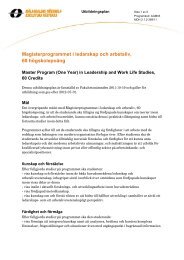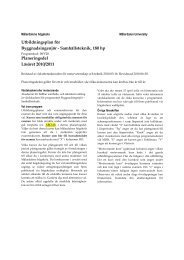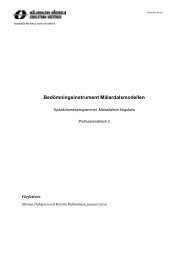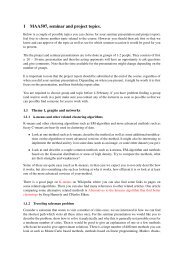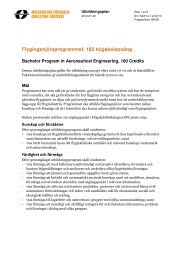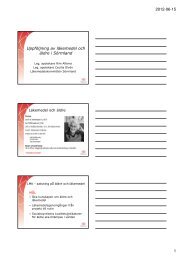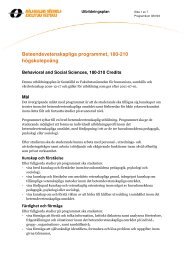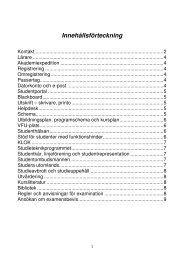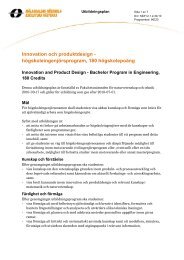Integrating Immigrant Children into Schools in Europe
Integrating Immigrant Children into Schools in Europe
Integrating Immigrant Children into Schools in Europe
You also want an ePaper? Increase the reach of your titles
YUMPU automatically turns print PDFs into web optimized ePapers that Google loves.
Chapter 4 – Measures for the Integration of <strong>Immigrant</strong> <strong>Children</strong> at SchoolEstonia, Spa<strong>in</strong>, France, Latvia or Portugal, <strong>in</strong> all of which a major proportion of immigrant citizens speakthe language of <strong>in</strong>struction (or, if there is more than one, at least one of them).Generally speak<strong>in</strong>g, l<strong>in</strong>guistic tuition is based on a teach<strong>in</strong>g approach to this language as a ‘second oradditional language’ (i.e. not the mother tongue of the pupils concerned). Meanwhile, <strong>in</strong> a few Nordiccountries (F<strong>in</strong>land, Sweden and Norway), as well as Estonia, Cyprus and Latvia, it is also possible to offerbil<strong>in</strong>gual tuition <strong>in</strong> which teachers use both the mother tongue of immigrant pupils and their schoollanguage of <strong>in</strong>struction.As regards the amount of time earmarked for teach<strong>in</strong>g immigrant pupils the host country language of<strong>in</strong>struction, major differences may be observed between countries, rang<strong>in</strong>g from 2 to 14 hours (or classperiods) a week.The <strong>in</strong>tegration of children <strong>in</strong> pre-primary education is not often the subject of priority measures on thepart of the authorities concerned. However, quite recently a few countries have started programmes to<strong>in</strong>troduce very young children to the language of <strong>in</strong>struction before they beg<strong>in</strong> compulsoryeducation. In Germany, these programmes are <strong>in</strong>tended for children who were born <strong>in</strong> the country orwho came to it when they were very young <strong>in</strong>deed. Belgium (the Flemish community), Lithuania,Luxembourg and Norway also provide reception classes for these children to prepare them for theirtransition to primary school (especially <strong>in</strong> terms of language). The Czech Republic, F<strong>in</strong>land and Sweden (<strong>in</strong>some municipalities) run special groups for immigrant children at pre-primary level to <strong>in</strong>troduce them tothe language of <strong>in</strong>struction so that they will be ready for their transfer to compulsory education. In theUnited K<strong>in</strong>gdom (England and Scotland), pre-school staff are advised to give particular attention toaddress<strong>in</strong>g the needs of children for whom English is an additional language.Even if there is considerable emphasis on the need to acquire rudiments of the language of <strong>in</strong>structionrapidly, other support measures are also implemented for the benefit of immigrant children.Among measures to help them with certa<strong>in</strong> areas of the curriculum, additional support for learn<strong>in</strong>gis the most widespread form of arrangement. Pupils are taught <strong>in</strong>dividually or <strong>in</strong> groups, generally dur<strong>in</strong>gthe part of the school timetable set aside for learn<strong>in</strong>g basic subjects such as read<strong>in</strong>g, writ<strong>in</strong>g ormathematics. Often countries that organise curriculum support activities at school may also modify thecontent of what is learnt or alter their assessment methods to take the special requirements of immigrantpupils <strong><strong>in</strong>to</strong> account. This applies to the Czech Republic, Cyprus, Slovenia, F<strong>in</strong>land and the United K<strong>in</strong>gdom(England, Wales and Northern Ireland). Furthermore <strong>in</strong> F<strong>in</strong>land, the certificate awarded on completion ofcompulsory education refers specifically to the mother tongue of immigrants, provided that at least halfof their <strong>in</strong>struction was given <strong>in</strong> that language, as well as <strong>in</strong> F<strong>in</strong>nish or Swedish.Reduc<strong>in</strong>g the number of pupils <strong>in</strong> each class is another measure adopted <strong>in</strong> some countries. It is oftenrecommended that separate classes or groups should conta<strong>in</strong> 15 pupils at most. Mixed group classes <strong>in</strong>ma<strong>in</strong>stream education may be required to <strong>in</strong>clude no more than a limited number of pupils of immigrantorig<strong>in</strong> (as <strong>in</strong> the Czech Republic, Germany and Italy).45



